In this post, we will show you how to access Windows Startup Settings or Advanced Startup Options in Windows 11/10 and also discuss how to use advanced troubleshooting tools to fix Windows problems.
Earlier, it was the Hardware Interrupts – pressing DEL for BIOS, F8 or F2 for boot menu – that helped computers take the necessary action. Now it is the software that boots so fast – making the use of advanced technologies – that your chances of making use of hardware interrupts are very low.
Advanced Startup Options Windows 11/10
To access the Advanced Startup Options settings screen in Windows 11/10, you have the following ways to do it:
- Shift > Restart using WinX Menu
- Via Context Menu
- Via Settings
- Using CTRL+ALT+Del > Restart
- Using Lock Screen > Restart
- Using shutdown.exe
- Using bcdedit.exe command line.
1] Using Restart option of WinX Menu
To boot into the Advanced Startup Options in Windows 11/10, you can hold down the Shift key and then click Restart from the Power Menu in Start. On restart, you will see the Advanced Startup Options screen.
If you need to troubleshoot problems with your Windows computer, you can click on Troubleshoot. When you do this, you are offered:
- Reset This PC option
- Advanced options.

If you wish to reset your PC, select Reset the PC option.
If you need to access other troubleshooting and repair tools, click on Advanced Options, to arrive at the following screen.
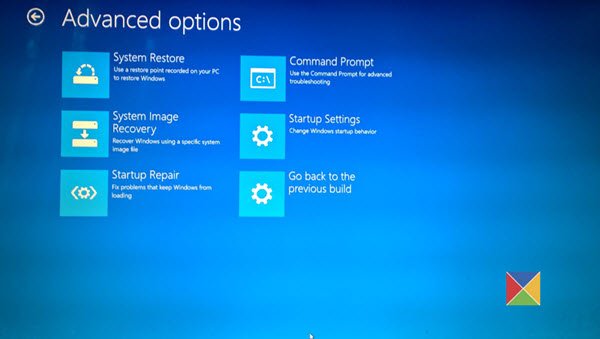
Here you will see:
- System Restore: Useful if you want to restore your Windows 10 PC.
- System Image Recovery: This lets you recover your Windows using a system image file.
- Startup Repair: Fixes startup problems
- Command Prompt: Using the CMD you can access the more advanced built-in Windows tools
- Startup Settings: It lets you change Windows startup options
- Go back to the previous build.
2] Using Context Menu
You can also add Boot to Advanced Startup Options to Context Menu and then use it.
3] Reboot PC into Advanced Startup Options via Settings
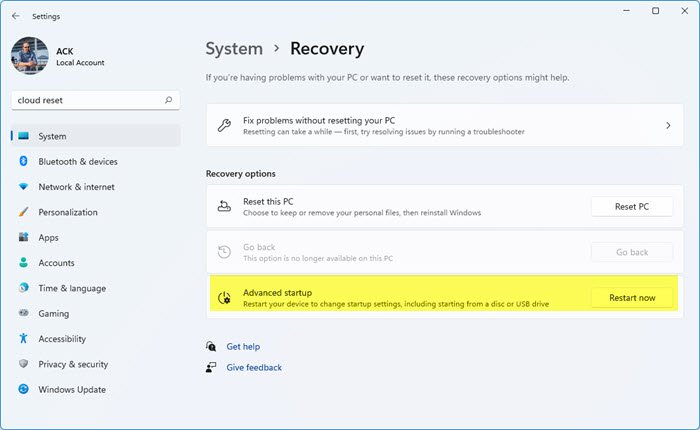
Windows 11 users need to press Win+I to open Settings > System Recovery and click on Restart now button against Advanced Startup.
If you wish to directly access these Advanced startup options when working on your Windows 10, you can do so via the Settings app of Windows 10 > Update & Security > Recovery > Advanced startup and click the Restart now button.
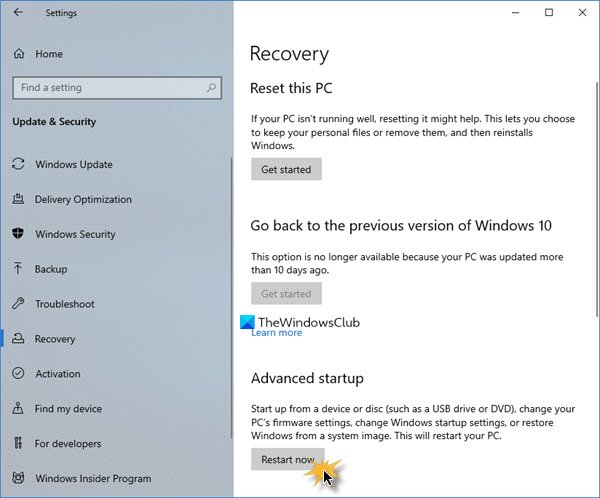
Clicking on Startup Settings will let you change the preset startup settings and options.
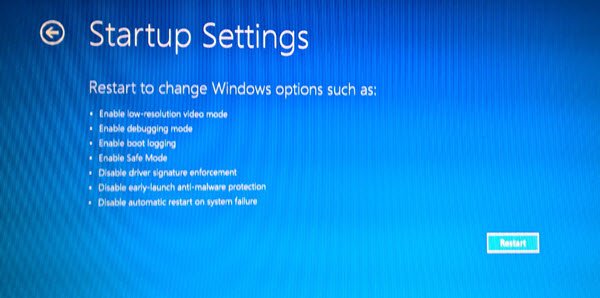
Here you can:
- Enable low-resolution mode
- Enable debugging mode
- Enable boot logging
- Enable Safe Mode
- Disable driver signature enforcement
- Disable early-launch anti-malware protection
- Disable automatic restart on system failure.
Windows 11/10 users may want to note that this is where you can enable Safe Mode.
Clicking on the Restart button will bring you to the following Startup Settings screen:
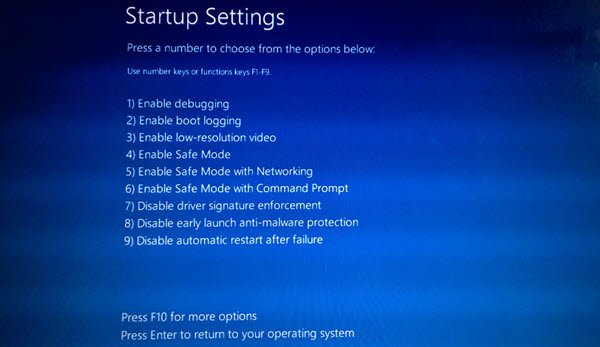
You have to press the keys to bring up the options.
Clicking on F10 will show you some more options including Launch recovery environment.
Pressing Enter will bring you back to your operating system.
Read: How to enter & use Windows Recovery Environment.
4] Using CTRL+ALT+Del > Restart option
- Press CTRL+ALT+DEL to open the Switch User screen
- Click the Power button in the bottom-left side
- Press the Shift key and select Restart.
You will boot to the Advanced Startup Options screen.
5] Using Lock Screen > Restart option
- Open the Lock screen
- Click the Power button in the bottom-left side
- Press the Shift key and select Restart.
You will boot to the Advanced Startup Options screen.
6] Reboot into Advanced Startup Options using shutdown.exe
The third method is a bit tough to remember. You have to open the command prompt and type the following:
Shutdown.exe /r /o
Hit Enter and see.
TIP: This post will show you Reset Windows 11 using Advanced Startup Options when PC won’t boot.
7] Reboot into Advanced Startup Options using bcdedit.exe command line
You can also Boot Windows directly to the Advanced Startup Settings screen using Command Prompt.
These settings are useful to know as, not only can you change your boot defaults here, but they can also be very useful to you if your computer will not start or you need to troubleshoot and fix other Windows problems.
Read: Windows fails to boot; Automatic Repair, Refresh, Reset PC also fails.
Windows Advanced Startup Options is missing
If the Advanced Startup Options screen is missing in Windows 11/10, open Command Prompt with admin privileges, type reagentc /enable and hit Enter. This will make Advanced Startup Options appear.
Related read: Could not find the Recovery Environment in Windows.
Very good! THX
You may be interested to know that you can configure your machine to open the boot menu each time you start your computer/laptop/Surface. Which means you can select the system image you want to load when you boot instead of having to choose a defaul
basically where is this(How set this in w10): Boot Order: USB stick/hdd»DVD drive»HDD1»HDD2…?
That’s not and never has been a feature of Windows. You change those settings in your BIOS.
How?
None of the startup settings offer a way to change the boot order.
My Windows 10 laptop does not have the GUI, it boots to a DOS type screen where you cursor down or up to choose the OS you want to boot to. I am not able to run bcdedit so I’m a little stuck with this now. Any thoughts from anyone?